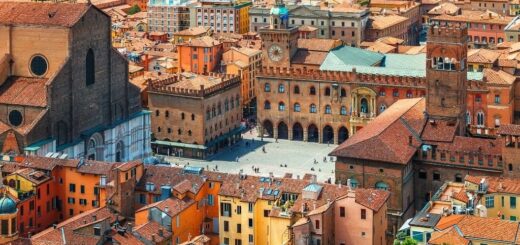Spain: Wines and Architecture of Northern Spain
Bilbao, San Sebastián


Bilbao: 3 nights
San Sebastián: 2 nights

6 Days Itinerary
Spain is the third largest producer of wine in the world, comprising diverse geographical regions and varying soils. Wines range from opulent reds to delicate whites, made from around 400 different grape varietals. The regions are classified into appellations called DOPs in the French AOC and Italian DOC manner. Overall, the surface area used in Spain to cultivate vineyards is the highest in the world.

Spanish wine regions
The Northern-Central area comprising La Rioja, Navarre and Ribera del Duero wine regions is one of the most famous in Spain. The topography and climate provide favourable conditions for the cultivation of the red wine grapes, most notably amongst them, Tempranillo. The wines are aromatic, spicy, full bodied and acidic. Their earthy, berry flavours are characterized by a smooth taste with a hint of oak. Some of them are considered amongst the best in the world.

The uniqueness of this region lies in the fact that here, the wine is sometimes overshadowed by architecture! The who’s who of the international architects’ fraternity have left their mark in the design of the wineries and related structures. No other region in the world can boast of this mix of avant-garde architecture along with historic vineyards. This has brought loads of international tourists who appreciate cutting edge architecture and enjoy acclaimed wines. To top it all, the culinary scene is also extraordinary. Michelin starred and local chefs prepare delectable modern Spanish cuisine providing an unforgettable gastronomic experience.
Bilbao: 3 nights

Bilbao makes for a great base due to its proximity to the wineries of the Northern-Central region. It is an important port city of the Basque country with an interesting mix of history and modernism. Lush green hills surround cobblestone streets of the old city center. Pintxos bars jostle with Michelin starred restaurants and family run establishments, all serving delicious cuisine.
Day 1: Wineries to visit:
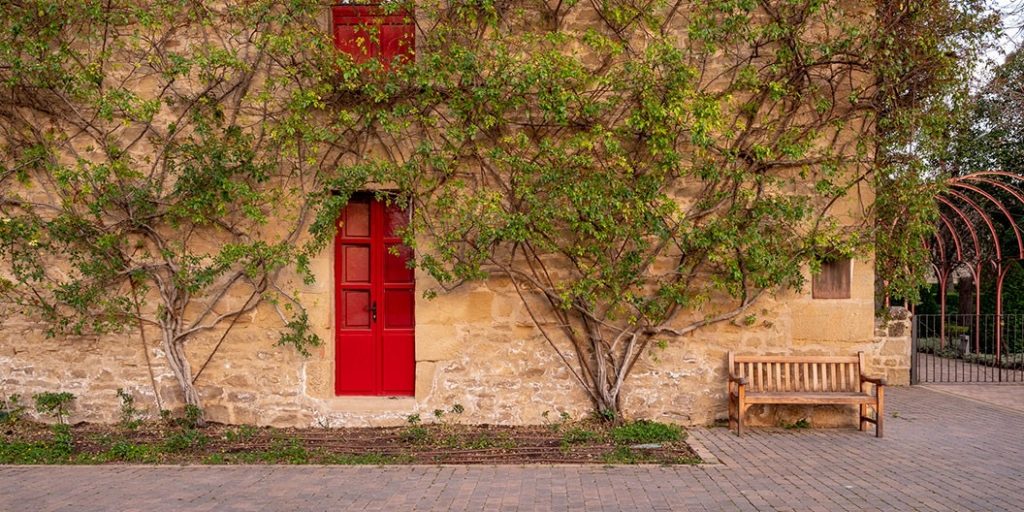
Founded in 1858 in Elciego in the Rioja region, Marqués de Riscal is one of the oldest wineries of Spain. Ultra modern facilities produce high quality wines making it an iconic winery of the area. In their own words, “We live by wine and we live for wine.” A ‘city of wine’ is created to learn about the history of the winery, the cellar, and the production facility. A vinotherapy spa, a conference center and a visitors’ center complete the experience.

Apart from the wines, what brought this winery on the global map was the commissioning of a hotel to the renowned architect Frank O’Gehry. The structure, completed in 2006, became an overnight sensation in the world of architects and wine enthusiasts because of its unique take on design.

The juxtaposition of the modern hotel structure against the old traditional structure of the winery creates a strong visual statement. The facade, made up of steel and titanium panels, evokes the form of the vines with twisted branches.
In the words of the winery, “the architect has chosen the colours of Marqués de Riscal in his facade – pink for red wine, gold like the braid on the bottles and silver for the foil cap.”


The undulating pink titanium plates change colour with the progression of the sunset. These titanium canopies shield the openings from sunlight while helping to create a masterpiece of architecture which has become the identity of Elciego. This hotel is a Luxury Collection Hotel, a jewel in the crown of the Marriott International Hotel.
A visitor to Marqués de Riscal can also enjoy a superlative culinary experience in their Michelin starred restaurant or the bar and the outdoor grill.

Located in the heart of the Rioja region at the foothills of Sierra Cantabria, Ysios is a boutique state of the art winery. It was founded in 2001 and is named after the Egyptian Gods who, according to mythology, taught people to cultivate grape vines. The famous Spanish architect Santiago Calatrava designed the striking silhouette inspired by a row of barrels and which seen from above is shaped like a wine glass. The sinuous structure reflects the hilly backdrop of the winery and is in complete harmony with the landscape. The roof clad in aluminum reflects the sunlight and the southern facade clad in cedar slats is reflected in the pools, creating a beautiful imagery.


At the Ysios winery, the micro climate and the soil contribute towards growing the best quality of grapes. Following methods handed down through generations, the wines produced are world class in quality. The winery relies on small plot vineyards and craftsmanship of the highest order to produce elegant reserve wines that reflect the true spirit of the Rioja terroir.
A vineyard, cellars and winery tour is available ending with a tasting session. There is a wine bar too offering wines and appetizers.

López de Heredia, the founder, started the construction of the winery in 1877, one of the first three in the Rioja region. Today, it stands out as one of the few family-run bodegas regulated by the DOC. Four generations of the family have devoted themselves to producing exceptional and unique wines. Vineyard care, selection of grapes, aging in oak barrels and later in bottles, all contribute towards the quality of the wines.
The winery is known for its traditional method of wine making in comparison with the production methods of other wineries. Sourcing grapes only from their own vineyards, using natural yeast and following strictly old procedures of barrel aging and racking produce amazing results.


In their 125th year, the winery decided to commemorate the anniversary by deciding to reuse their stand made for a world fair in 1910 and build an exterior shell to cover it. It commissioned the project to Zaha Hadid, the internationally renowned architect, who is famous for her innovative treatment and artistic detailing of various modern structures. For the winery, “she combined tradition with modernity, nature with architecture and wine with aesthetics”. The pavilion was displayed at the Food and Drink fair in Barcelona and later relocated permanently to the winery, making it an extension of the existing bodegas. Its use was changed to house a tasting room, a shop and an exhibition area.
The winery thus makes a statement about preserving the past, while looking to the future, making it a destination for its architecture apart from the wines.
Day 2: Wineries to visit

Since 1927, Bodegas Protos has been known for its excellent wines, its quest for expanding the brand and winning accolades for its success. It was the first winery of the Ribera del Duero region. Its vineyards are located on diverse soil types over 1400 hectares on low altitude hills. The wines are from Tempranillo grapes, they are harvested manually and the selection process is also manual. It is one of Spain’s largest wineries with exports to over 91 countries.


In 2008, Bodegas Protos inaugurated a new state of the art winery in Peñafiel. It was designed by the prestigious firm Rogers Stirk Harbour + Partners. The architects skilfully built upon the legacy of the winery and created a modern masterpiece to help Protos produce better and sustainable wines.

The use of traditional materials like wood and stone and terracotta roofing tiles help create a continuity with the traditional architecture of Piñafiel. The cylindrical vaulted roofs provide beautiful lighting to the flexible glass enclosed areas below. The building contains modern production facilities as well as custom designed tasting rooms and administrative areas. The cellar beneath is used for storage of the wine and has a link to the old winery.

The Faustino group, with a 160 years of history in winemaking, is the owner of Bodegas Portia. The Martínez family, which owns the group, while expanding in the Ribera del Duero region, commissioned the Portia winery in 2010, to produce wines from the vineyards bought by them in the surrounding areas.

Around 160 hectares of land is cultivated using sustainable agriculture practices. The resulting wines produced have an intense flavour profile and violet hues.
Tradition, combined with innovation, while respecting the environment bring out wines with character and personality, richness and elegance.


The winery is designed by the prestigious architectural firm Foster and Partners. The structure is a three pointed star in the heart of Ribera del Duero representing modernity and the future. Each point is dedicated to a specific part of the winemaking process: fermenting the wine in stainless steel tanks, maturing it in barrels and aging it in bottles. Using steel, wood, concrete and glass, the design creates a powerful symbol for Bodegas Portia. The winery is an architectural icon in the world of wine. It perfectly combines aesthetics with functionality. Visitors get to experience a unique combination of architecture, art, gastronomy and wines.

The guided tour offers a chance to learn about the winemaking process and a tasting session in its Gastrobar. A combination of wine and tapas is served in the Triennia Gastrobar. It blends haute cuisine with traditional flavours.
Sightseeing in La Rioja region:
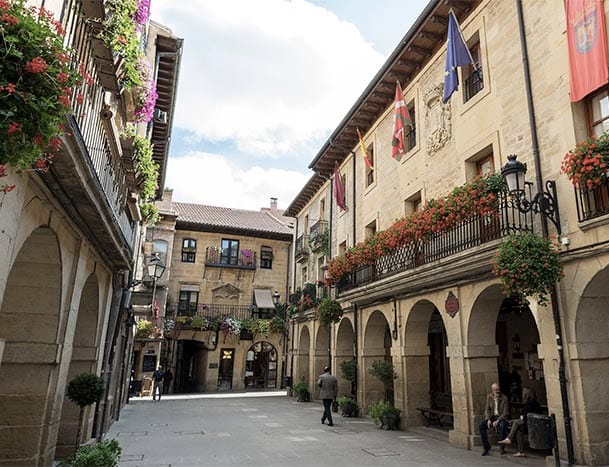
Laguardia is around 1 hour 15 minutes from Bilbao and near the wineries of Marqués de Riscal and Ysios. It is a walled town, founded in the 10th century as a defence outpost for the kingdom of Navarre. It is set atop a hill, overlooking the vineyards, with the Cantabrian mountains in the background. It is one of Spain’s most beautiful towns.
The winding, medieval streets are almost intact with some splendid examples of Renaissance and Baroque architectural works. The whole walled area is car free, with lively bars and restaurants along the streets.

Due to the town’s wine making past, the ground beneath the cobbled streets and houses is a maze of caves used as wine cellars. Some of them are open for tours and are worth visiting.
Overall, a charming town well worth a visit.

Logroño is the capital of the province of La Rioja and was an important stop on a pilgrimage route in medieval times. The architecture reflects the traditions and history of the Middle Ages. Picturesque squares lure visitors to indulge in their famous cuisine and visit the numerous bars.
Day 3: Sightseeing in Bilbao:
Guggenheim Museum:

Bilbao’s most famous attraction, the Guggenheim Museum, is a must-see masterpiece of design. Designed by the famous architect Frank Gehry in 1997, the building itself is a work of art. The cladding of 35,000 sheets of titanium is an awe inspiring architectural feat. The sculptural form of the structure leads inside into a memorable experience of appreciating art.
Campo Volantín Footbridge:
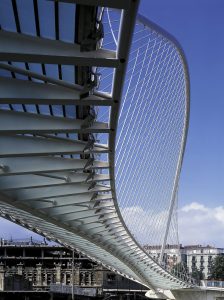
Designed by Santiago Calatrava in 1994, the Campo Volantín Footbridge provides a striking modern pedestrian crossing on an estuary near the Guggenheim Museum. The sweeping steel parabolic arch along with the glass surfaced deck and the concrete supports provide a contrast of materials.
Bilbao also has a wealth of historical monuments, museums, a charming old town, golden beaches and exceptional gourmet restaurants.
San Sebastián: 2 nights
(1 hour 15 minutes by car from Bilbao)
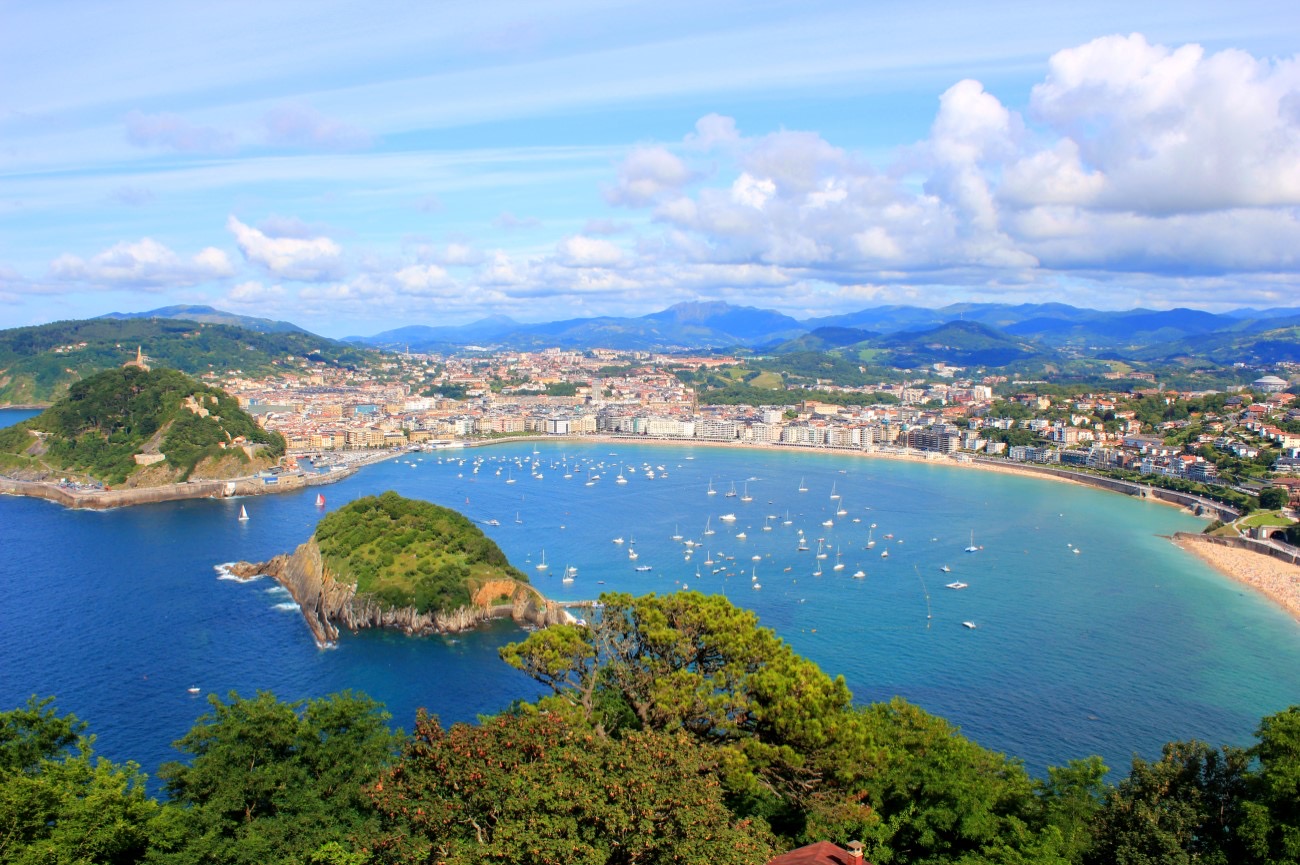
San Sebastián, officially known as Donostia-San Sebastián, is a picturesque resort town in Spain’s Basque Country. It is known for its fabulous beaches, world-renowned restaurants and a cobblestoned old town. The city has a captivating cultural atmosphere too, with an array of music festivals, folk festivals and culinary fairs. International and European stars are regulars at the International Film Festival in September.

But the main reason for the popularity of San Sebastián is its excellent cuisine. It has the second highest concentration of Michelin starred restaurants in the world per square kilometre! Aside from this haute cuisine, the Basque version of Tapas, known as Pintxos, served in innumerable Pintxos bars, is extremely famous. San Sebastián is also home to some of the best food markets.
Pintxos:
San Sebastián’s unique ‘Pintxo’ culture makes it the gastronomic capital of Spain. Pintxos are bite-sized pieces of bread topped with a variety of fresh ingredients. They are held together by a ‘pintxo’ (cocktail stick), hence the name. The miniature, elaborate preparations pack a flavourful punch and hence their popularity!

A Pintxo outing is an informal way to enjoy dinner while socializing. The Old Town is full of Pintxo bars, both traditional and modern, guaranteeing a complete experience. Each bar is filled with freshly prepared colourful ready-to-eat Pintxos. They have their own specialties, so bar crawl is popular.The variety is overwhelming. Pintxos are enjoyed with drinks, many times ending up enough as dinner!
Some traditional Pintxos: (Vegetarian)
Tortilla:

This is a Spanish omelette, served in a small size, often stuffed with potatoes. There are a lot of variations, often with mushrooms, cheese or spinach.
Croquetas:
These are like croquettes, mostly filled with creamy mushrooms and deep fried. They are rich, yet light with a concentration of flavours in the small size.

Idiazabal Cheese Pintxo:

This Pintxo consists of marinated Idiazabal cheese with olive oil, garlic, peppercorns, rosemary, thyme and extra virgin olive oil. Idiazabal is a sheep’s milk cheese that is usually smoked.
Some of the Pintxo bars in Old Town:
La Concha Beach: (Playa de la Concha)
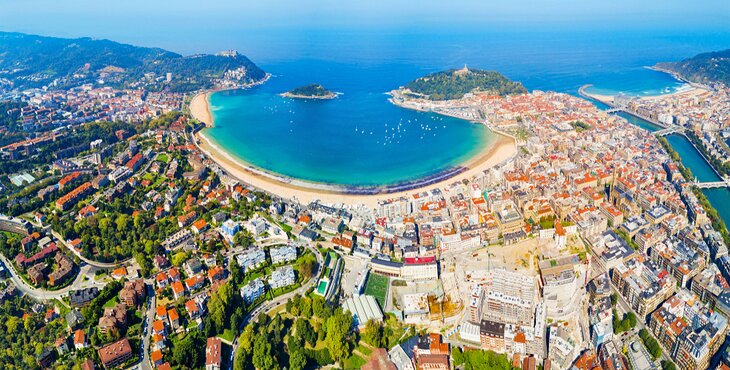
The beach along the picture-perfect crescent shaped La Concha Bay is the most iconic sight in San Sebastián. The white sands and the turquoise waters are an unbeatable combination. During the summer months, visitors swarm along the pedestrian beachfront promenade and take shade under parasols when sunbathing.
Old Town: (Parte Vieja)
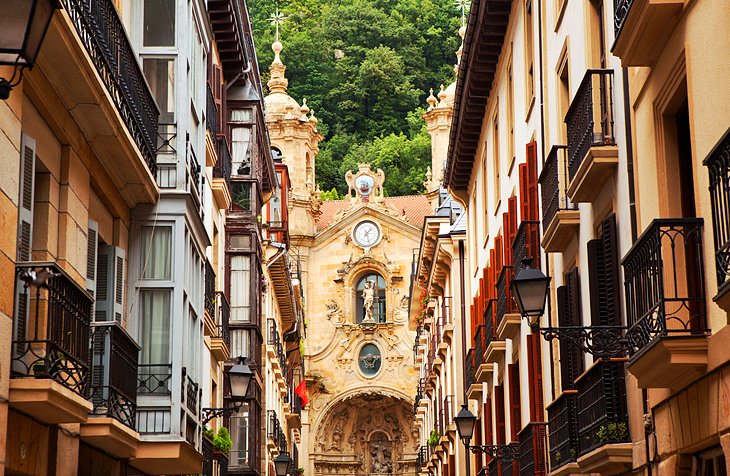
The Old Town is one of the most happening places in San Sebastián. There are many historical buildings in the area including churches, a city hall, a library and a central plaza.
Tourists as well as locals flock to the lively streets to dine in the numerous Pintxo bars and restaurants. The boutique shops too are worth visiting.
Mount Urgull: (Monte Urgull)

Mount Urgull is located at one end of La Concha bay, overlooking the Old Town. It has many lookout points with picturesque views of San Sebastián, the sea and La Concha bay. Its military past can be felt in some of the marks left on the city as well as in the ramparts of the fortifications.
Having enjoyed this trip to Bilbao and San Sebastián, this Culinary Journey ends with an onward connection from San Sebastián.



